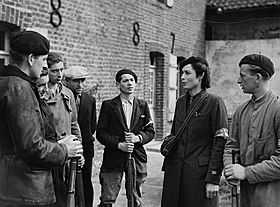Germaine Tillion facts for kids
Quick facts for kids
Germaine Tillion
|
|
|---|---|
 |
|
| Born | 30 May 1907 Allègre, Haute-Loire, France
|
| Died | 18 April 2008 (aged 100) Saint-Mandé, France
|
| Education | École du Louvre École Pratique des Hautes Études École des langues orientales |
| Occupation | Anthropologist |
| Parent(s) |
|
Germaine Tillion (born May 30, 1907 – died April 18, 2008) was a French ethnologist. An ethnologist studies different cultures and peoples. She is well known for her work in Algeria in the 1950s. She also bravely joined the French Resistance during World War II. Because of this, she was held in the Ravensbrück concentration camp.
Contents
Germaine Tillion: A Brave Anthropologist
Germaine Tillion was born in Allegre, France, on May 30, 1907. Her father, Lucien Tillion, was a judge. Her mother, Émilie Cussac Tillion, was an art historian. Her mother also fought in the French Resistance. Germaine had a sister named Francoise. They grew up in a Catholic family.
Early Life and Studies
Germaine spent her younger years with her family in Clermont-Ferrand. Later, she moved to Paris to study social anthropology. This is the study of how human societies and cultures work. She learned from famous teachers like Marcel Mauss. She earned degrees from several important schools in Paris.
Between 1934 and 1940, she traveled to Algeria four times. There, she did fieldwork. This means she lived among people to study their lives. She studied the Berber and Chaoui people in the Aures region of Algeria. This research helped her prepare for her advanced degree in anthropology.
Joining the French Resistance

When Germaine returned to Paris in 1940, France had been invaded by Germany. She immediately began to resist the occupation. Her first act was helping a Jewish family by giving them her family's official papers.
She became an important member of the French Resistance. This was a secret group fighting against the German invaders. She helped prisoners escape. She also gathered important information for the Allied forces from 1940 to 1942.
Sadly, a priest named Robert Alesch betrayed her. He had joined her resistance group and gained her trust. Germaine was arrested on August 13, 1942. She was later sent away in a large group of prisoners in 1943.
Life in Ravensbrück Camp
On October 21, 1943, Germaine Tillion was sent to Ravensbrück. This was a German prison camp near Berlin. Her mother, Émilie, who was also a resistance fighter, was sent there too.
While in the camp, Germaine secretly wrote a funny play called "Le Verfügbar aux Enfers." This play described the daily life of the prisoners. It helped entertain her fellow prisoners. At the same time, she carefully studied and wrote about life in the concentration camp. Her mother was killed in the camp in March 1945.
Germaine escaped Ravensbrück in the spring of 1945. This happened during a rescue mission by the Swedish Red Cross. The mission was arranged by Folke Bernadotte.
In 1973, she published a book called Ravensbruck: An eyewitness account of a women's concentration camp. In this book, she shared her own experiences as a prisoner. She also shared her detailed research about how the camp worked. She wrote about the prisoners' movements and the terrible things done by the SS guards. She reported that there was a gas chamber at Ravensbrück. This was important because some people thought there were none in the camps in Western Europe.
She also wrote about how the camps had two main goals. One was to carry out the "Final Solution," which was the plan to kill many people. The other was to use prisoners for forced labor to help the war effort.
After World War II
After the war, Germaine Tillion focused on studying the history of World War II. She also researched the terrible acts committed by the Nazis. She also studied the Soviet Gulags, which were prison camps in the Soviet Union. She did this work from 1945 to 1954.
She also started an education program for French prisoners. As a professor at the École des hautes études en sciences sociales, she went on 20 scientific trips. These trips were to North Africa and the Middle East.
Helping in the Algerian War
In 1954, Germaine returned to Algeria. She wanted to understand the situation as the Algerian War of Independence was about to begin. She believed the main cause of the conflict was that the Algerian people were becoming very poor.
To help, she started 'Social Centers' in October 1955. These centers offered higher education and job training to people in rural areas. This helped them survive in the cities.
On July 4, 1957, during the Battle of Algiers, she met secretly with National Liberation Front leader Yacef Saadi. She wanted to try and stop the violence and attacks. Germaine Tillion was one of the first people to speak out against the use of torture by French forces during the war.
Her Later Years
Germaine Tillion continued to speak out on important issues. She spoke against the poverty of the Algerian people. She also spoke against the use of torture by the French in Algeria. She was also a strong supporter of women's rights in the Mediterranean region.
In 2004, she joined other French thinkers in speaking out against torture in Iraq.
To celebrate her 100th birthday, her play "Le Verfügbar aux Enfers" was performed in 2007. It was shown at the Théâtre du Châtelet in Paris. She was an Honorary Professor at France's School of Advanced Studies in the Social Sciences when she passed away in 2008.
Awards and Recognition
Germaine Tillion received many important awards for her bravery and work:
- Grand-croix de la Légion d'honneur: This is one of France's highest awards. Only five women have ever received this honor.
- Grand-Croix de l'Ordre national du Mérite
- Prix mondial Cino Del Duca (1977)
- Croix de Guerre 1939-1945
- Médaille de la Résistance
- Médaille de la déportation et de l'internement pour faits de Résistance
- Grand Cross of the German Merit (2004)
On February 21, 2014, French President Francois Hollande announced that she would be honored at the Panthéon. This is a famous building in Paris where many important French figures are buried. She was honored there in May 2015. Her coffin at the Panthéon does not contain her remains. Instead, it holds soil from her gravesite. This was because her family did not want her body moved.
On May 11, 2015, a social science research center at the University of Angers was renamed after her. It is now called Maison de la Recherche Germaine Tillion.
See also
 In Spanish: Germaine Tillion para niños
In Spanish: Germaine Tillion para niños


